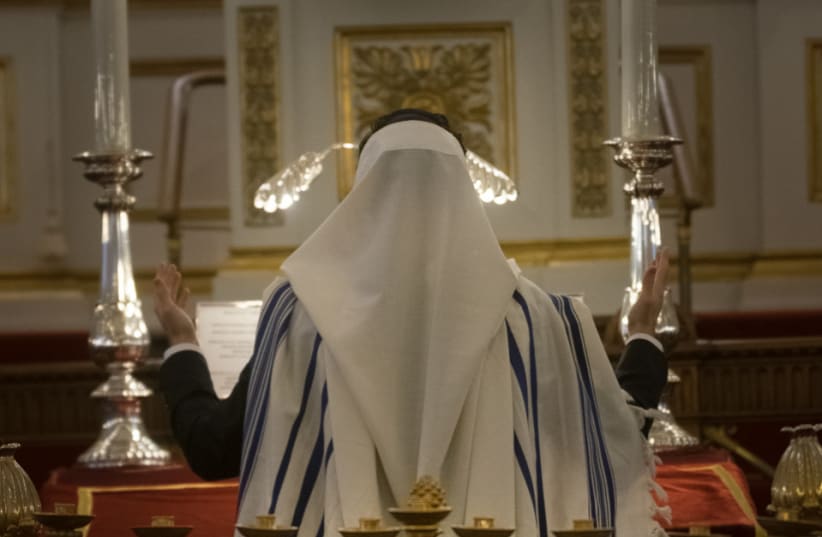Twenty-five-year-old Edan Tamler has the most unexpected job title for someone his age: serving as chief cantor of Denmark. How did this American-Israeli (who has since participated in the Israeli version of X Factor) decide to devote his time to leading prayers in a tiny Jewish community in Europe?
Tamler was born in New York City and grew up in Jamaica Estates, Queens. In 2012, when he was 15 old and fresh off of finishing his second year at Ramaz, his family made aliyah. The Tamlers relocated to Eshchar in Southern Galilee.
“After moving to Israel, I was recruited to be a participant in the first season of Israel’s X Factor,” he said from Copenhagen. Tamler made it all the way to the final as part of a band called Fusion, which was assembled by the judges during the show.
“After moving to Israel, I was recruited to be a participant in the first season of Israel’s X-Factor.”
Edan Tamler
“It was an amazing experience, one that strengthened my dream of becoming a professional musician and made that prospect seem more tangible than ever,” he said of his experience on Israeli television. “I was subsequently signed to a development deal by pop musician Ivri Lider, who was a mentor of mine [on the show] and helped me come into my own as a singer-songwriter and artist.”
One year later, Tamler’s musical journey continued in a surprising direction, as the lead singer of the IDF Orchestra, “where I served as the ceremonial voice at Israel’s annual memorial and celebration ceremonies nationally and abroad for three years.”
He said that during his army service, he “felt as though I was missing an outlet for Jewish expression. Ironically, the strong passion I had felt for Jewish culture and music in New York hadn’t been as prevalent in my life in Israel.”
With this in mind, Tamler turned to the chief cantor of the IDF, Shai Abramson, in search of cantorial lessons. “He had become a friend and a mentor early on in my service as we frequently shared the stage at these national ceremonies together,” he said. “He sang “El Maleh Rachamim,” a memorial prayer remembering those who had perished, and I, “Hatikvah,” Israel’s national anthem.”
Tamler studied with Shai for two years. “Other than being a fantastic teacher, mentor and friend, he also knew the ins and outs of the cantorial industry, assisting me in beginning to find work as a cantor and in religious choirs,” he explained.
After the army, Tamler moved back to New York for a year to teach music at the Ramaz Lower School, and to be reunited with his then long-distance girlfriend Rachel Kastner, “who has recently become my wife this past month,” he said excitedly. “During this time I continued growing as a cantor, educator and musician, and upon arriving back to Israel, I had decided to enroll in the Tel Aviv Cantorial Institute to learn under the tutelage of the great cantor Naftali Hershtik.”
Tamler’s wife, Rachel, studied in Copenhagen in 2018 during a semester abroad. “During that year, Rachel found that she loved the city, met incredible people, and most importantly to this story, felt a deep connection to the local Jewish community,” Tamler said, explaining that they decided to visit there as a couple later that year.
During their trip, this long-distance couple had dinner with Denmark’s chief rabbi, Jair Melchior, and his family. “He spontaneously asked me to lead the morning Shabbat service the next day,” Tamler recalled, and added jokingly, “I’m confident that Rachel had organized the entire thing in advance, seeing an opportunity for me to showcase my work.”
He agreed to the offer, and it surprisingly turned out to be a sort of audition, as the community was looking for a cantor at the time. “Rachel and I were in the midst of moving to Tel Aviv, and so the Danish Jewish community offered an arrangement where I would be part-time, going to Copenhagen each month to teach music and Judaism in the local Jewish school and lead services in the synagogue on Shabbat and holidays,” said Tamler.
He began his role as the chief cantor of the Great Synagogue in Copenhagen in 2019. “Our monthly schedule worked wonderfully for several months and then COVID-19 hit,” he recalled.
He was then “separated,” as he called it, from the community for nearly six months. “Luckily, I was able to fly into Denmark in time for the High Holy Days in 2020, and since then I have been traveling back and forth to Denmark for Jewish holidays and community events.”
The Danish Jewish community
The Danish Jewish community has a rich history and is deeply embedded in Danish society. Tamler said that next month, “Queen Margrethe II of Denmark will be coming to the synagogue to celebrate the 400th anniversary of Judaism in Denmark.”
He added that the Jewish community of Copenhagen “has a Modern Orthodox framework but is composed of roughly 1,000 Jews of all levels of affiliation. The synagogue building is nearly 200 years old and incredibly well kept, in large part due to the fact that Danish Jews and Jewry were greatly protected from the Nazi occupation of Denmark in WWII.”
During the war, Danish Jews were saved by escaping to nearby neutral Sweden, where they continued practicing Judaism in their unique way. “Due to this, the synagogue service today is very similar to how it was all those years ago,” said Tamler. “The Copenhagen Jewish community also has a rich history of Danish Jewish liturgy and music, and that it is a huge part of many community members’ identity. The music is fascinating to listen to and read about, and it’s incredible to see how music can be so integral in binding people together in a shared identity. I have spent hundreds of hours reading old partitures and sifting through 50-plus-year-old recordings in order to learn these melodies and preserve their place in the synagogue.”
One of his favorite tunes is the local version to the “Kol Nidre” prayer, “which plays with more major scales than the more widely sung Ashkenazi version. In addition to the uniqueness of the melody, the Kol Nidre moment in the Great Synagogue is incredible and unlike anything I’ve experienced elsewhere. Yom Kippur eve is one of those nights where the synagogue is truly filled to capacity; nearly 1,000 Danish Jews fill the pews, many standing in the same places that their parents, grandparents and great-grandparents did so many years ago. The cantor stands facing the congregation, something that is less common in Orthodox Jewish prayer spaces, and the entire room is singing and praying as one.”
Tamler concluded that even after three years on the job, “I am still learning more and more traditions and local melodies, which I think is a great testament to the richness of Jewish culture and life in Denmark. It’s an honor to be a part of preserving its existence, and to have a role in strengthening the identities of Danish Jews through song and prayer.”

